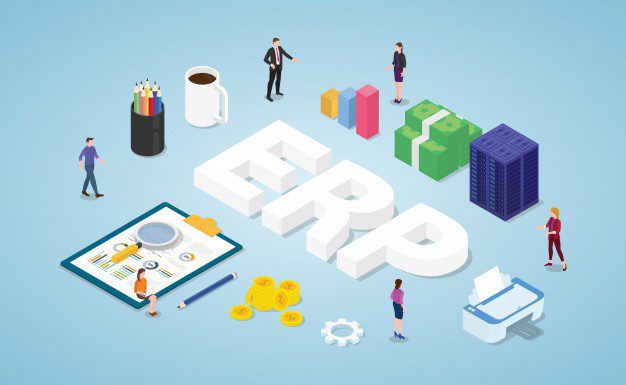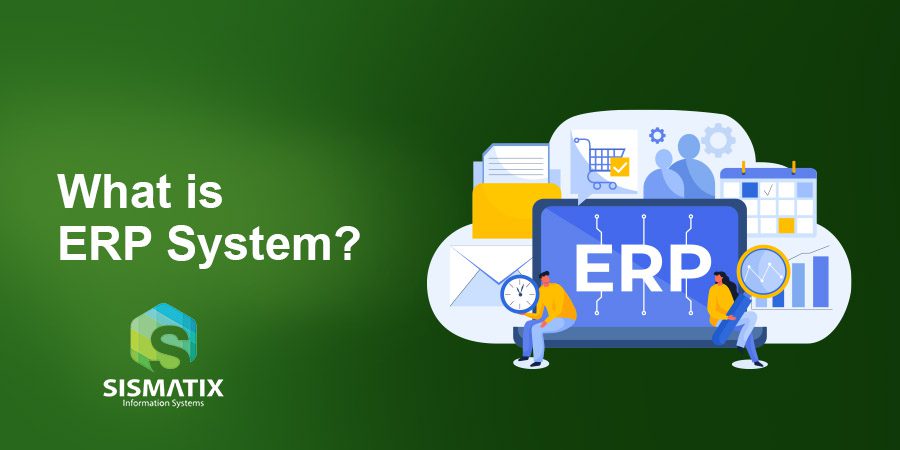By the end of this article, you will be know what is ERP and familiar with the definition of ERP system and how it’s going to affect the flow and management of different processes in any organization. In addition, you will know when to use an ERP system and how it’s going to be implemented and what are the industries that can implement an ERP solution.
What is ERP System?

ERP stands for Enterprise Resource Planning. ERP system is a business process management software that allows an organization to use a system of integrated applications to manage the business and automate many back office functions related to technology, services and human resources.
Instead of relying on several software vendors with different standalone data vessels; ERP system relies on a centralized database to store and retrieve data in real time to manage day-to-day processes in different departments which keeps the integrity of data and eliminate data duplication.
Organizations may implement ERP system for the following reasons:
- They need to computerize organization’s workflow and business processes instead of using papers or spreadsheets.
- Replace out of date ERP system.
- Replace old ERP system that is not qualified enough for new expansions and non-flexible to upgrades or customizations.
History

what is ERP? In 1960s, the need to speed up the manufacturing processes and to balance the production with customer demands came up with creating a software known as MRP – Manufacturing Materials Planning. This type of computer software helped in manufacture planning, maintain stock levels and define purchase strategies.
Because of the improvements in hardware and mainframes developed by IBM in 1970s, MRP was implemented in several large manufacturing factories, and by the 1980s, especially after developing a financial management system for the first time, MRP got more capabilities and improvements, hence, it was named MRP II or Manufacturing Resource Planning.
By 1990s, the ERP term raised for the first time when these type of software systems were extended to not only manage inventory and production, but also to control and manage other functions such as Human Resources (HR) and Accounting to become that ERP we know this days.
Today’s ERP system is more advanced and complicated than ever for sure; it can be installed on premise with a centralized server in your company, or on the cloud. It can be a desktop application or web based application. Nowadays, some significant tasks can be performed using mobile devices. ERP system extended to have advanced reporting services, integrated with Marketing Automation and Customer Relationship Management (CRM).
The value of using ERP system

The growth of investments in ERP solutions is an indication of how important this type of software for organizations, not only those working on production factories, but almost all industries. Any business consists of different functions; hence, the use of ERP solution and purchasing ERP modules – which we will come up to next – will depend on your organizational needs and what is meant to be achieved. The main business benefits of using an ERP system are:
- Minimize operational costs through adopting best practices in different activities.
- Improve efficiency by enhancing and clarifying business processes.
- Improve data consistency and integrity by reducing error and eliminating duplication.
- Fewer point of failure and the need to work with different software vendors to manage daily tasks.
- Improve accuracy of financials.
- Increase data security at all phases.
- Reporting and alerting on critical conditions.
The main goal of using ERP system is to centralize and share data between different departments and individuals in the organization to streamline business processes, while managers rely on ERP systems to analyze financial data, organizational performance and to improve decision-making processes.
ERP Modules

As I mentioned earlier, ERP system consists of several modules, each to manage a specific function inside your organization. One of the main characteristics of an ERP system is its modularity, and the success of one depends on the ability and flexibility to fulfil organizations’ requirements with all their differences and customizations. A small business may just need an inventory and financial management systems, while a larger one may need in addition to that, a Human Resource, Payroll and Production management system.
Main ERP Modules can be summarized as follows:
- Financial Accounting: General Ledger (GL), Fixed Assets, Payable and Receivable, Cash Management.
- Human Resources (HR): Employee File, Recruiting, Attendance Management, Training, Payroll, Benefits and Deductions, Promotions.
- Manufacturing: Bill of Materials (BoM), Quality Control (QC), Job Orders, Manufacturing Process, Production Planning.
- Sales: Sales Order, point of Sales (POS), Quotation and Price Lists, Sales and Invoicing, Shipping and Sales Commissions, Customers Management and Sales Reporting.
- Supply Chain: Purchase Order (PO), Purchase Invoices, Stock Levels and forecasting, Vendors and Payments.
- Inventory Management: Out/In transactions, Stocktaking, Stock movement, Stock Open Balance.
- Customer Relationship Management (CRM): Potentials and Customers’ contacts, commissions, campaigns, tasks and meetings.
We need to mention that sometimes CRM is not considered part of ERP system, but it can be easily integrated to ERP system to automate and streamline the business process.
ERP Implementation
Adopting an ERP solution itself does not guarantee its success in an organization. Purchasing an ERP solution must be consisted of and followed by well-formed implementation processes, which may involve some – if not all – of the following:
- Preparing network infrastructure.
- Bringing suitable devices with recommended specifications.
- Installing ERP system.
- Moving data from other data sources if exist to the new system.
- Configure users and their privileges.
- Training end-users, which considered one of the most important phases in ERP implementation process.
- Follow up with ERP end-users to strengthen their experience and solve issues that may occur during the first period of implementation.
- Evaluate the success of ERP solution.
ERP implementation is a critical step toward the success of any ERP solution, no matter how good the solution is, or how many modules it consists.
ERP Implementation time varies, for small businesses it may take 6 months, and it may take a year for large businesses depending on business size, number of modules, customizations and how ready are the organization to take the wheel and go live.
Industries
What industries use ERP system? Simply we can say ERP system can cover any type of businesses as long as it has one of the functions mentioned in the ERP modules section. We may categorize these types of business in:
- Retail: Super Markets, Mobile Shops, Clothes.
- Manufacturing: Food and Beverages, Pharmaceutical Manufacturing, Feeds, Plastic manufacturing, metal manufacturing, Furniture manufacturing, Printing and advertising.
- Services: VIP services, Transportation, Consulting, Financials.
- Construction and Real estate.
- Medical industry such as hospitals and medical centers.
- Hospitality: Restaurant, Hotel.
- Education Industry for Schools or Universities
- Publishing and advertising.
Trends

Every day’s inventions and new technologies have a great impact in the development of ERP systems. The most important trends we may heard about and is continuing to expand are:
- Cloud Computing: where the organization has not to worry about hosting servers inside its building or pay a huge amounts of money to purchase equipment and backup devices. Throw this heavy load to another vendor and focus on your core activities. SaaS (Software as a service) is an implementation of cloud computing where you can use an ERP system and your vendor will be responsible for providing you with the 24/7 availability and support, secured data centers, hosting and backing up your data, upgrading devices and computer hardware, all that for a little amount of money that you can pay in annually, quarterly or monthly basis.
- Mobile Application: Anytime, anywhere, you can perform your key business functions using mobile devices through applications designed specifically to serve that purpose.
Conclusion
Adopting an ERP solution may cost you money, but when implemented in the right way you’ll find a great potentiality to success. A great ERP system is the one fits you the most tied to the flexibility to changes and customizations.



